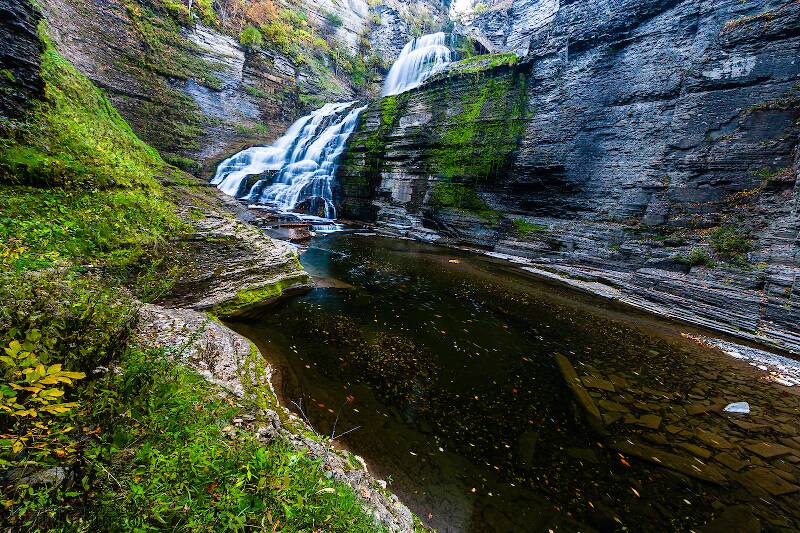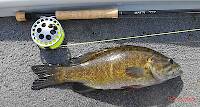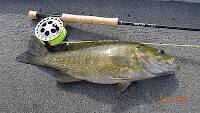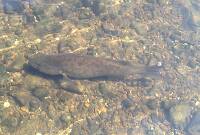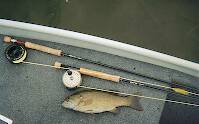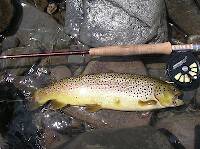
Hex Mayflies
Hexagenia limbata
The famous nocturnal Hex hatch of the Midwest (and a few other lucky locations) stirs to the surface mythically large brown trout that only touch streamers for the rest of the year.
Featured on the forum

This one was surprisingly straightforward to identify. The lack of a sclerite at the base of the lateral hump narrows the field quite a bit, and the other options followed fairly obvious characteristics to Clostoeca, which only has one species, Clostoeca disjuncta.

Troutnut is a project started in 2003 by salmonid ecologist Jason "Troutnut" Neuswanger to help anglers and
fly tyers unabashedly embrace the entomological side of the sport. Learn more about Troutnut or
support the project for an enhanced experience here.
LittleJ on Nov 17, 2007November 17th, 2007, 11:39 am EST
Why do we tie,fish, and catch fish on black stone fly nymphs. I was looking through the stone fly pics on here and did not see a single nymph that looked like the "black" stonefly that I tie. I originally started looking to try and see if I could improve on my pattern but unless I missed something the best improvement I could make would be to get rid of the black and switch to dark brown.
jeff
jeff
JOHNW on Nov 17, 2007November 17th, 2007, 1:54 pm EST
Jeff,
I look at it this way: Most of the places we fish stonefly nymphs are pretty rough and toumble and the trout get a split second look and make their decision. So black and dark brown aren't really all that far apart.
JW
I look at it this way: Most of the places we fish stonefly nymphs are pretty rough and toumble and the trout get a split second look and make their decision. So black and dark brown aren't really all that far apart.
JW
"old habits are hard to kill once you have gray in your beard" -Old Red Barn
Flybyknight on Nov 18, 2007November 18th, 2007, 7:38 am EST
There are two species of small dark Stoneflies in the early spring that are of interest here. Black Stonefly: Taeniopteryx navalis, and the Brown Stonefly, with T. hatching around late February, and S. following a few weeks later.
The nymph of the former in 14-16 2XL is a dark brown to black, while the latter in 16-18 is brown to dark red/brown. They are often found together, which quite frankly confuses me sometimes when the adults are on the snow banks.
Dick
The nymph of the former in 14-16 2XL is a dark brown to black, while the latter in 16-18 is brown to dark red/brown. They are often found together, which quite frankly confuses me sometimes when the adults are on the snow banks.
Dick
Lightly on the dimpling eddy fling;
the hypocritic fly's unruffled wing.
Thomas Scott
the hypocritic fly's unruffled wing.
Thomas Scott
LittleJ on Nov 18, 2007November 18th, 2007, 1:12 pm EST
What about larger black stones? I tie a black in all the same sizes as a golden. Maybe I'm not even imitating a particular species and they just take it because it looks tasty. I don't know? I agree with John in that your fishing riffles so color is less important, I suppose I just figured that this big black stone fly that I always fished with was an actual species. Who knew.
Jeff
Jeff
Martinlf on Nov 18, 2007November 18th, 2007, 4:28 pm EST
Jeff, there is a little black stonefly, size 18, that hatches around here in March and April. If you fish the Letort or Yellow Breeches then it's good to have nymphs, wets, and dries to match it.
"He spread them a yard and a half. 'And every one that got away is this big.'"
--Fred Chappell
--Fred Chappell
Flybyknight on Nov 19, 2007November 19th, 2007, 11:30 am EST
Oops! The little brown stonefly that I was referring to above (my home water: East Branch of the Delaware) is Strophopteryx faciata.
The next Stonefly to hatch is the Giant Black Stonefly: with the ferocious name Pteronarcys dorsata. It too is dark brown, but the ventral is sort of yellow / orange. That is what I believe the discussion is about, but this little bugger in size 12 to 16 does not come off till early April.
Another Black Stonefly: Isogenoides hansoni in sizes 12 to 16 follows a week later. It is black, with light green markings around the head and thorax.
I tie in a chocolate color, except for P. in which case the overhand weave keeps me humble.
Dick
The next Stonefly to hatch is the Giant Black Stonefly: with the ferocious name Pteronarcys dorsata. It too is dark brown, but the ventral is sort of yellow / orange. That is what I believe the discussion is about, but this little bugger in size 12 to 16 does not come off till early April.
Another Black Stonefly: Isogenoides hansoni in sizes 12 to 16 follows a week later. It is black, with light green markings around the head and thorax.
I tie in a chocolate color, except for P. in which case the overhand weave keeps me humble.
Dick
Lightly on the dimpling eddy fling;
the hypocritic fly's unruffled wing.
Thomas Scott
the hypocritic fly's unruffled wing.
Thomas Scott
Quick Reply
Related Discussions
Topic
Replies
Last Reply
6
May 12, 2013
by Tigermidge
by Tigermidge

